Even before the Hawker Hurricane gained immortal fame in the Battle of Britain, work had already begun on a major upgrade of the fighter. As in all other such projects, the aim was to improve overall performance and the effectiveness of on-board armament.
First: stronger engine
The most significant modification consisted in replacing the engine with a Rolls-Royce Merlin XX, whose two-speed compressor significantly boosted high-altitude performance. The Mk.I Hurricanes, equipped with the Merlin III engine, lost power quite noticeably above 20,000 ft (approximately 6,000 m). At an altitude of 25,000 ft (approximately 7,600 m), the Hurricane Mk.I did not exceed 310 mph (less than 500 km/h), and as it climbed, performance dropped even more sharply. The Merlin XX, on the other hand, provided maximum performance at this very altitude, accelerating the aircraft to 330 mph (over 530 km/h). The more powerful engine not only increased maximum speed in level flight and rate of climb, but also fire resistance due to a new, pressurized cooling system filled with a 70:30 mixture of water and glycol, which unlike pure glycol did not create inflammable vapours. The use of such a cooling system also helped reduce the engine’s operating temperature and thus increase its reliability, extend service life and limit oil leaks, which were the bane of early Merlins. The Hurricane became a much better and more mature design. The installation of the Merlin XX resulted in very subtle changes to the design: an extension of the fuselage section in front of the cockpit by four inches, and an enlargement of the radiator and carburettor air intake.
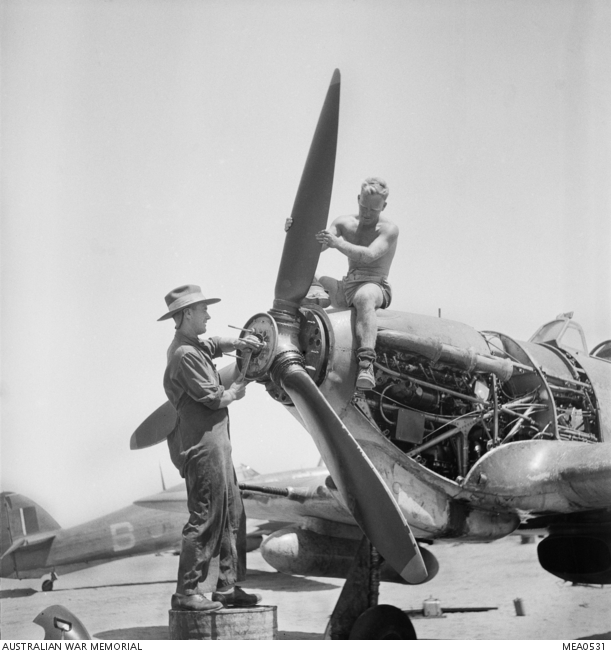
Hurricane IIc during servicing. Merlin XX engline clearly visible
The first flight of a Hurricane powered by a Merlin XX – P3269, the Mk.IIA prototype – took place on 11 June 1940. Series production, limited by engine availability, commenced in August, and the following month, in the midst of the Battle of Britain, the new fighter underwent its baptism of fire with No. 111 Squadron RAF.
The Hurricane Mk.IIA retained the previous model’s armament of eight 0.303 inch machine guns; in fact, their number was increased to a dozen in the Mk.IIB, however this was not a qualitative change.
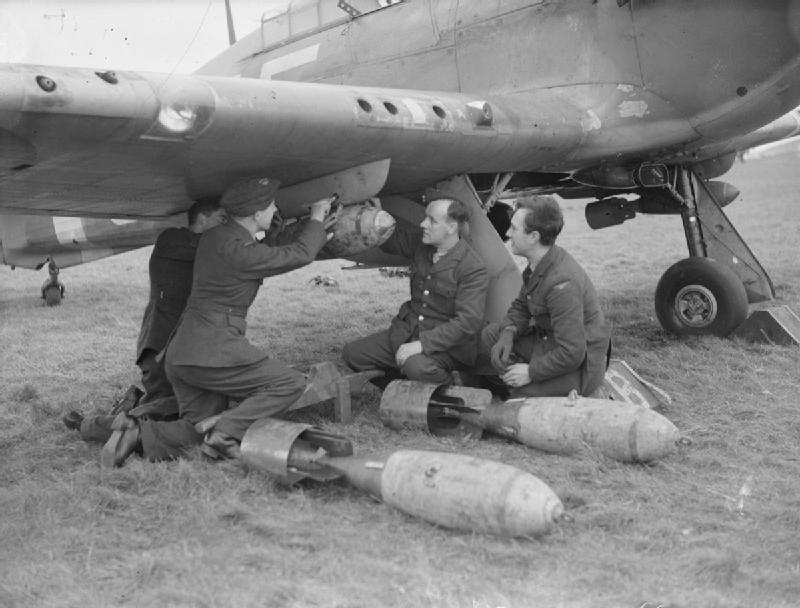 Arming of the Hurricane MK IIb with 250lb bombs. Of the six machine guns in wing you can see five of them. Sixth one is removed and barel is taped. It is beacuse of it’s spend chutes slot placed at the bomb rack location. Photo: wikimedia commons.
Arming of the Hurricane MK IIb with 250lb bombs. Of the six machine guns in wing you can see five of them. Sixth one is removed and barel is taped. It is beacuse of it’s spend chutes slot placed at the bomb rack location. Photo: wikimedia commons.
Where did the Hurricane cannons come from?
Already towards the end of 1935, the F.37/35 specification was issued, describing the requirements for a fighter armed with four 20 mm cannons. The search for suitable armament led to the commencement of cooperation with the French manufacturer Hispano-Suiza, whose offer included a 20 mm aerial cannon. At the time, Hispano-Suiza had for several years been producing a modified Oerlikon FF S cannon, designated HS.7 and HS.9, for the Dewoitine D.501 and 510, and was working on the very modern HS.404 cannon. Collaboration bore fruit in the opening of a new factory in Grantham in 1938, which commenced the licence manufacture of HS.404 cannons and ammunition. The first tests with the 20 mm gun mounted on a Hurricane (L1750) were carried out in May 1939. The cannons were installed in long fairings under the wings, and caused a 20 mph (approximately 32 km/h) drop in top speed. Contrary to what can often be found in the literature, these were not Oerlikon cannons, but Hispano-Suiza HS.404s, which differed in appearance from those known from later years and perhaps for this reason were mistaken by certain authors – to name but F. Mason and R. A. Franks – for Oerlikons. Leslie Appleton, the designer responsible for the armament of Hawker fighters, wrote nothing about Oerlikons in his memoirs. Furthermore, photographs of L1750’s armament always show an early version of the HS.404.
 Hurricane IIc, Z3899/JX-W from 1 squadron RAF, Autumn 1941. Aeroplane lost in accident on 22 November this year. Unusual carton insignia visible – Indian head. Photo from Tony O’Toole collection.
Hurricane IIc, Z3899/JX-W from 1 squadron RAF, Autumn 1941. Aeroplane lost in accident on 22 November this year. Unusual carton insignia visible – Indian head. Photo from Tony O’Toole collection.
The problem with the HS.404 Mk.I was that it was fed from a drum magazine with a capacity of just sixty rounds, which translated into a burst of no more than five seconds. This failing aroused scepticism in the Air Ministry, and in consequence the serial production of Hurricanes with C wings housing four HS.404 Mk.I cannons was not started. A recommendation was given to develop a belt feed system that would supply the requisite quantity of ammunition when mounted in the wings of the fighter. In anticipation of the second version of the HS.404, only one Hurricane prototype (V7360) with four drum-fed cannons was built.

20mm cannons installed in production Hurricane IIc
But work on the new system took much longer than had been planned, and the prototype of the modified Hispano-Suiza 404 Mk.II was transported from Chatellerault to the British Isles just before the Fall of France. Interestingly, the design was inspired by a Soviet-made cannon captured by the Spanish rebels. All that remained to be done was to provide the new design with the reliability required for combat applications. Trials conducted on Z2461, which was the first Hurricane with a Merlin XX engine and HS.404 Mk.II cannons (and thus a prototype of the Mk.IIC version), showed that the guns regularly jammed after firing no more than a few shots. Eventually, the problem was eliminated, albeit at the cost of a slight drop in rate of fire.
 Hurricane Mk IIc, Z3899/JX-W, 1 Sqaudron RAF, November 1941. Aeroplane painted with Day Fighter Scheme, upper surfaces in Dark Green and Ocean Grey, under surfaces in Sea Grey Medium. Early insignia type A1 and early fin flash. Unusual Sky band on fuselage, with slot for serial. Artwork by Zbyszek Malicki.
Hurricane Mk IIc, Z3899/JX-W, 1 Sqaudron RAF, November 1941. Aeroplane painted with Day Fighter Scheme, upper surfaces in Dark Green and Ocean Grey, under surfaces in Sea Grey Medium. Early insignia type A1 and early fin flash. Unusual Sky band on fuselage, with slot for serial. Artwork by Zbyszek Malicki.
Combat usage of cannon-armed prototypes
The first victories on a Hurricane fitted with 20 mm cannons were scored by F/Lt Roddick Lee “Dick” Smith from No. 151 Squadron RAF, who upon his arrival at RAF North Weald in early June 1940 discovered two of these unusually armed fighters standing in a hangar. These were L1750 and V7360, equipped with two and four HS.404 Mk.Is respectively. L1750 became his personal aircraft, on which he made some ninety operational flights in July and August. As he recalled, leading a section in a slower aircraft allowed less experienced pilots to maintain formation, which was tactically advantageous.
On 14 July, he shot up a Bf 109, which, burning, plummeted towards the sea. For this action, he was awarded a probable victory.
On 13 August, F/Lt Smith reported the destruction of Do 17. But on 22 August, L1750 was damaged in combat and had to be withdrawn for repairs.
On 31 August, F/Lt Smith, this time flying on V7360, reported a probable victory over a Bf 109. L1750 was returned to service in early October, once again becoming Smith’s personal aircraft.
On 29 October, F/Lt Smith intercepted a section of Do 17s, however his left cannon jammed, and he failed to achieve any visible hits. He made his last flight on L1750 on 21 November. A few days later, F/Lt Smith left No. 151 Squadron RAF and took over command of No. 255 Squadron RAF.
On 12 December, the fighter was handed over to No. 601 Squadron RAF. It was still flying with the unit in February 1941.
The combat history of V7360 was not as long. On 4 September, following a brief period of service with No. 151 Squadron RAF, it was transferred to No. 46 Squadron RAF. While there, it was flown mainly by F/Lt Alexander Rabagliati. On 5 September, he attacked a Bf 109, striking it with an accurate burst of 20 mm shells; the enemy aircraft literally disintegrated. On 7 September, he hit a Do 215, but reported only damaging it. On the next day, 8 September, F/Lt Rabagliati once again attacked bombers, but at a critical moment, after firing just eighty shells, his guns fell silent, and although they then started working again, he failed to score any hits. On 11 September, V7360, piloted by Sgt Stanley Andrew, landed with a damaged undercarriage. The fighter was sent to the Hurricane factory at Langley, where it became a test aircraft.
The Hurricane IIc is born
Series production of the Mk.IIC version finally began in early 1941, with the first aircraft arriving at No. 242 Squadron RAF in late March, and at No. 257 and No. 3 Squadrons RAF in April. At first, these were just individual aircraft, intended for commanders and more experienced pilots. There were no squadrons wholly equipped with the Hurricane Mk.IIC in the spring and summer of 1941. The first victory on a Mk.IIC was scored by the commander of No. 242 Squadron RAF, S/Ldr Wilfrid Patrick Francis Treacy, who destroyed a Ju 88 on 1 April 1941.
There is no doubt that in 1941 flying offensive sorties over occupied France required considerable courage. Nevertheless, the fighter was inferior to the new Bf 109F. Although the Merlin XX engine had improved its performance, the Hurricane was beset by significant inherent limitations that no modifications could effectively remove. The thick aerofoil profile generated so much drag that no significant increase in top speed could be achieved. Pilots who switched from the Mk.I to the Mk.IIA were impressed by the latter’s enhanced performance, but when the Mk.IIB version became available, they also felt a marked deterioration in aileron efficiency due to the increase in inertia caused by the extra weight. It is not surprising, therefore, that the four external machine guns were sometimes removed from the Mk.IIB – as were the external cannons from the Mk.IIC – when they were flown purely as fighters. This modification was not made in units stationed in the UK, but was quite common in Africa and the Far East. In the British Isles, the Hurricane was simply withdrawn from daytime fighter squadrons and given other tasks.
Hurricane Mk IIc, BD868/QO-P from 3 squadron RAF, August 1941 – June 1942. Aeroplane was not attached to one pilot, but until March 1942 it was usually flown by P/O Hunt. During service Hurricane BD868 flew around 60 combat flights. It started with day missions (eg. attack on German Fleet during “Channel Dash” – “Operation Cerberus” on 12 February 1942, flown by P/O Hunt) and since May 1942 night intruder missions of the 3 Squadron „Night Flight Detachment” in Manston. Following aerial victories were achieved on BD868:
- 20 May 1942 P/O Desmond James Scott* (RNZAF) shot down unidentified aeroplane over Dutch island Texel
- 1 czerwca 1942 F/Sgt Colin Homer Smith (RCAF) shot down one Do 217 and damaged second in Dutch city Gilze vincinity. The same pilot did not return from mission on 7/8 June 1942.
*Later, this New Zealand aviator became known for his achievements as commander of the Tangmere Typhoon Wing and the youngest Group Captain in the Allied Air Forces. Awarded DSO, OBE, DFC and Bar. Author of two memory books: “Typhoon Pilot” and “One More Hour”.
Camouflage and markings similar to JX-W mentioned above, then in Spring 1942 it was repainted night intruder scheme. Decals for that aeroplane you find in 70036 Hurricane Mk IIc Model Kit. Historical research was prepared according to, Operations Record Book of the 3 Squadron RAF. Artwork by Zbyszek Malicki.
Hurricane at night
Already in the autumn of 1940, some of the daytime fighter squadrons were transferred to night operations. The Hurricane was quite well suited to night flying, as it had a widely spaced undercarriage and was easy to fly, which reduced the risk of accidents. However, it had no radar. The first idea for night-fighting tactics, developed from mid-1941, consisted in using a specially modified Douglas Havoc Turbinlite which flew accompanied by two Hurricanes. Once such a formation had been guided in by ground-based radar and the target acquired by on-board radar, the Havoc would illuminate the target with a powerful searchlight located in the front of its fuselage, while all the two accompanying Hurricanes had to do was to shoot down the bomber, its pilot blinded, with their four cannons. In theory, this was banally simple, and belief was soon high that success must follow once the Havoc and Hurricane pilots master their teamwork to perfection. A stringent training programme was therefore implemented, involving numerous resources and people; inevitably, crashes occurred, and aircraft and pilots were lost. In the end, the costs and losses completely outweighed the gains. Only one German bomber was shot down in this way. Turbinlite squadrons were finally disbanded in January 1943, when the focus shifted to developing classic radar-equipped night fighters, such as the Beaufighter and Mosquito. Twelve more Hurricanes fitted with the miniaturized AI Mk.VI radar were manufactured; these were assigned to No. 245 Squadron RAF and No. 247 Squadron RAF in October and November 1942 respectively. The additional aerodynamic drag generated by the radar antennas and the increase in weight resulted in such a drop in performance, especially when additional tanks were installed, that the aircraft became practically useless. The fighter was unpleasant to fly, nose-heavy, and generally aroused little enthusiasm – especially when pilots learned that they would be re-equipped with Typhoons.
Hurricane Mk IIc, BE500/LK-A, flown by W/Cdr Denis Smallwood. Aeroplane roughly repainted with Night Intruder Scheme, with the Day Fighter Scheme translucent eg. on the leading edge . Photo: wikimedia commons. 
Hurricane Mk IIc, BE500/LK-A, “United Provinces – Cawpore I”. Aeroplane repainted with Night Intruder Scheme. W/Cdr pennant of the pilot Denis Smallwood visible under cockpit. Artwork Zbyszek Malicki.
Another photo of the Hurricane BE500/LK-A in black camouflage. Underwing roundels are verpainted. Under nose red “A” is painted. Photo from Tony O’Toole collection.
The Hurricane proved much more successful in intruder operations. Lone Hurricanes would patrol the vicinity of German airfields, looking for bombers that were taking off or landing. The tactic flourished when, in the early months of 1942, units began to receive aircraft fitted with additional fuel tanks, which enabled them to operate further afield, even near Paris, and “visit” several airfields in a single operational flight, or circle close to a target and wait for prey. These missions were extremely hazardous. Just imagine: a night flight far over enemy territory, or over the sea, where any failure or navigational spelt captivity – at best. The attack itself would take place near the airfield, which was usually heavily defended by flak. There was no shortage of searchlights, artillery and night fighters along the way either. Successes entailed losses which, when viewed in proportion to the number of operations carried out, were much higher than in daytime aerial combat.
The famous Czech fighter ace Karel Kuttelwascher became a specialist in operations of this type.
Karel Kuttelwascher – the most effective Hurricane night fighter pilot
Night fighter camouflage
During the war Hurricanes flew both day and night missions. Since summer 1941 RAF fighters were painted in Day Fighter Scheme consisting the following colours – Dark Green and Ocean Grey on top surfaces and Medium Sea Grey on lower. Hurricanes designated to night missions wore Night Intruder Scheme – they were painted Night Black. Neverheless, RAF was looking for effective camoulflage as black paint used to paint aircraft reduce speed.. First upper surfaces were painted Dark Green and Mixed Grey (a mixture of Medium Sea Grey and Night Black). Finally a compltety new camouflage was developed by the Royal Aircraft Establishment and the Air Interception Unit and on 11th January 1942 it was introduced. It consisted only two colours – Medium Sea Grey covering lower surfaces and upper together with Dark Green.
 Hurricane Mk IIc, BE500/LK-A fights “Beadeker Blitz” type Luftwaffe air raid – Autumn 1942. Artwork by Piotr Forkasiewicz.
Hurricane Mk IIc, BE500/LK-A fights “Beadeker Blitz” type Luftwaffe air raid – Autumn 1942. Artwork by Piotr Forkasiewicz.
Baedeker Blitz
At night on the 28th and 29th March 1942 RAF Bomber Command conducted a huge bom bing raid on German harbour – Lubeck. British attack caused a lot of damages and high casualty rate among civilians. Germans learnt that further bombardment might cause morale dawnfall and decided to organise retaliatory attacks on British towns and cities. Gustav Braun von Stumm, the spokesman of German Foreign Office, said that “We shall go out and bomb every building in Britain marked with three stars in the Baedeker Guide”. The air raids begun in April 1942 and lasted until 1944. German bombers attacked places of cultural importance but proved ineffective, although caused deaths of 1673 civilians and destruction and damage of 50,000 houses. Yet, it did not make British to stop their bomber offensive and Luftwaffe Kampflieger (Bomber Force) lost 40 bombers. At that same time Luftwaffe carried out hit-and-run attacks on coastal towns using Focke Wulf 190 fighter bombers.
 Hurricane IIc BE500/LK-A repaint with new camouflage, Dark Green and Mixed Grey (Ocean Grey) uppersurfaces and left in previous Night Black undersurfaces. Roughly repainted aeroplane has paint peeling at teading edges and traslucent in some places . Aeroplane flown by W/Cdr Smallwood and Polish fighter F/Sgt Henryk Trybulec among others. Photo – Tony O’Toole collection.
Hurricane IIc BE500/LK-A repaint with new camouflage, Dark Green and Mixed Grey (Ocean Grey) uppersurfaces and left in previous Night Black undersurfaces. Roughly repainted aeroplane has paint peeling at teading edges and traslucent in some places . Aeroplane flown by W/Cdr Smallwood and Polish fighter F/Sgt Henryk Trybulec among others. Photo – Tony O’Toole collection.
A Pole in 87 Squadron RAF
 Henryk Józef Trybulec – 1912-1993 – was one of the most experienced Polish Air Force pilots. Born in Radomyśl Wielki near the Mielec town, where a big aviation factory was built. Graduated high school in Mielec and in served obligatory militry service in 32 Liasion Squadron in 3rd Aviation Regiment in Poznań. In 1934 he has graduated advanced pilot course in Grudziądz . From 1936 to 1939 Trybulec served as pilot’s training instructior in Ławica airfield in Poznań. He has fought in September Campaign 1939 with 32 Recconaissance Squadron in Army Łodź. He conducted dangerous recce sorties over German Panzer colums advancig towards Warsaw. Trybulec flew PZL 23 Karaś as well as obsolete RWD-8 aeroplanes. According to his personal notes he has completed 1950 flying hours in Poland. When arrived to Britain he has served several training units: 15 OTU, 10 B&GS, 55 OTU. At last in October 1941 he became operational pilot in Polish 317 Fighter Squadron. Then he was serving with following units:
Henryk Józef Trybulec – 1912-1993 – was one of the most experienced Polish Air Force pilots. Born in Radomyśl Wielki near the Mielec town, where a big aviation factory was built. Graduated high school in Mielec and in served obligatory militry service in 32 Liasion Squadron in 3rd Aviation Regiment in Poznań. In 1934 he has graduated advanced pilot course in Grudziądz . From 1936 to 1939 Trybulec served as pilot’s training instructior in Ławica airfield in Poznań. He has fought in September Campaign 1939 with 32 Recconaissance Squadron in Army Łodź. He conducted dangerous recce sorties over German Panzer colums advancig towards Warsaw. Trybulec flew PZL 23 Karaś as well as obsolete RWD-8 aeroplanes. According to his personal notes he has completed 1950 flying hours in Poland. When arrived to Britain he has served several training units: 15 OTU, 10 B&GS, 55 OTU. At last in October 1941 he became operational pilot in Polish 317 Fighter Squadron. Then he was serving with following units:
- 87 Squadron RAF – March 1942 – September 1942
- 533 Squadron RAF – September 1942 – December 1942
- 308 Polish Squadron – December 1942 – March 1944
- 302 Polish Squadron – October 1944 – July 1946
During serivice in Polish Air Force in Britain Henryk Trybulec flew:
- 55 combat sorties/ 95.5 hours
- 38 operationa sorties / 46.5 hours
- 14 hours and 55 minutes night flights
Decorated with Cross of Valour 2 times. After the war he could not return to communist Poland and married Isabelle Bridges.
With 87 Squadron RAF served also other Polish fighters: F/Sgt Antoni Beda F/O Antoni Waltoś (KIA in first air raid on Operation Jubilee, 19 ugust 1942)
Hurricane Mk IIc, BE500/LK-A, piloted by W/Cdr Smallwood in Operation Jubilee 19 August 1942 and by F/Sgt Henryk Trybulec in May 1942. Visible roughly applied new camouflage as well as overpainted fundation and rank pennant insignias. Artwork by Zbyszek Malicki.
Operation Jubilee
The search for new tasks for the ageing Hurricane led to the development of its fighter-bomber version. In August 1941, trials commenced with initially two 250 lb, and later two 500 lb bombs. The fighter-bomber version made its combat début in November 1941, but ultimately did not find widespread use in the European Theatre of Operations. By the autumn of 1942, no more than two fighter-bomber (Hurribomber) squadrons were operating simultaneously. They played a much greater role on other fronts.
One of the most important operations in which Hurricanes IIb and c took part was „Jubilee”. On the 19th August 1942 Canadian units together with British Commandos, US Rangers and with the support of tanks, landed in French town Dieppe and in its area. Main task of that operation was to gather information about German defense on French coast and gain experience before invasion. RAF’s task was to cover the invasion fleet, landing forces and to provoke Luftwaffe into a major battle.
Hurricanes were used as a close support aircraft – Mk.IIbs bombed targets and Mk.IIcs used their cannons to attack “softer” targets. For RAF it was very busy day – squadrons flew 2-3 missions during that day. However, the whole operation was a failure and Canadian units suffered heavy losses. Yet, gained experience was priceless and lesson learnt from it helped to prepare the Normandy landing.
Three air raids a day – 87 Squadron
In the Operation Jubilee 87 Squadron flew three air raids. Squadron task was to attack targets with cannon fire just after they were bombed by bombers, mostly Hurri-Bombers Mk IIb.
- First Air Raid, after 7:35 AM. When Bostons from 88 Squadron bombed coastal battery”Rommel”, W/Cdr Smallwood (BE500/LK-A) leas a column of tree sections of four aeroplanes throught deadly Flak fire. Polish pilot F/O Antoni Waltoś was killed, and P/O Baker was shoot down and landed safely with parachute.
- Second Air Raid after 10:15 AM, lead also by W/Cdr Smallwood (BE500/LK-A). Squadron entered combat just after Hurricane Mk IIb from 175 and 253 squadrons dropped their load. They fired at German positions on cliffs at “Rommel” battery and all pilots returned safely.
- Third Air Raid after 1:25 PM, was planned with cooperation of the Hurricanes Mk IIb from 174 squadron. This time 87 squadron was lead by F/Ltn Stuart Hordern (HL864/LK-?). Smoke screen over Dieppe prevented combined attack and squadrons operated separately. Targets of opportunity were attacked with cannons including MG nest on the cliff and lorries at the background of defensive positions. F/Sgt R. Gibson was killed in action.
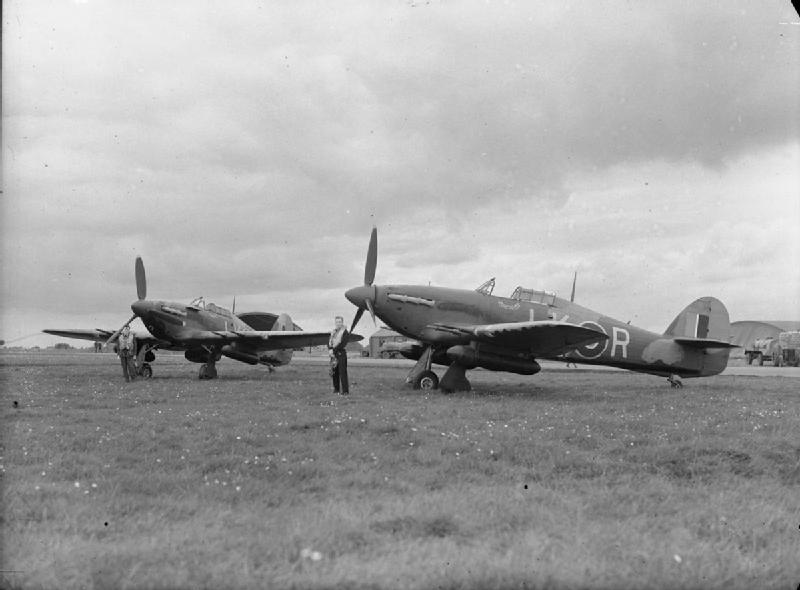 Two Hurricanes Mk IIc from 87 Squadron RAF. HL864/LK-? ”Nightingale”, P/O F. W. Mitchell, AND HL865/LK-R ”Night Duty”, F/Sgt B. Bawden. Charmy Down, Summer 1942. Aeroplanes configured for “NightIntruder” missions with z 44 galon fuel tanks under wings. Photo: wikimiedia commons.
Two Hurricanes Mk IIc from 87 Squadron RAF. HL864/LK-? ”Nightingale”, P/O F. W. Mitchell, AND HL865/LK-R ”Night Duty”, F/Sgt B. Bawden. Charmy Down, Summer 1942. Aeroplanes configured for “NightIntruder” missions with z 44 galon fuel tanks under wings. Photo: wikimiedia commons.
Time passed, new designs appeared, and further modernisation of the Hurricane was no longer viable. In 1942, many of the units stationed in the British Isles received the powerful Hawker Typhoon or fast Spitfire, while those that continued to operate the Hurricane Mk.II were sent to other theatres of operations. To all intents and purposes, the beginning of 1943 marked the end of the Hurricane Mk.IIC’s combat career in Great Britain. Interestingly, however, the tempo of production remained unchanged throughout the first quarter of the year, at approximately 250 aircraft per month, for demand for the fighter had not disappeared.
In North Africa, the Hurricane served on the front line for the entire campaign. From 1940 onwards, of course, these were the Mk.IIA, B, C and D versions, equipped with the Merlin III and, later, with the Merlin XX, which performed every conceivable task. From fighter to bomber to reconnaissance aircraft and, finally, specialised tank destroyer. Versions with HS.404 cannons, however, appeared in the Mediterranean Theatre of Operations quite late in the war, in February/March 1942, while No. 1 Squadron SAAF received them only in late summer 1942.
In the Far East, the Hurricane Mk.II fighter was in action almost from the start of the conflict, also in Dutch markings, and as a bomber it remained on the front line until April 1945. In combat against Japanese fighters, the Hurricane proved a formidable tool, provided the pilot was able to make use of its strengths. Importantly, however, the Allied fliers had no choice but to learn, as the first Spitfires appeared in this theatre only in September 1943, gradually taking over the fighter role. Soon, the Hurricane became a mere assault aircraft on this front too. Again, its advantages – structural simplicity, high resistance to damage, ability to operate from poorly prepared airstrips, ease of handling and piloting – all played their part, and, although there were plans to send Typhoons to Burma, the Hurricane was eventually replaced with the American P-47D, and even then only in the last months of the war.
Finally, some 3,000 Merlin XX aircraft, of which over 1,000 were Mk.IICs, were passed on to the USSR under the Lend-Lease agreement. Deliveries of the Mk.IIC started in April 1942. In the last week of the war, 574 Mk.IICs (plus approximately 200 Hurricanes of other versions) were still in service with the Soviet Air Force.
Interestingly, Soviet mechanics contributed to increasing the number of Hurricanes armed with cannons. From mid-1942, the Hurricane Mk.IIB was rearmed with a set of two 20 mm ShVAK cannons and two 12,7 mm UBK machine guns, which was quite a sensible choice compared to the relatively ineffective Brownings. More than 1,000 such aircraft – which were also capable of carrying six RS-82 unguided missiles – were manufactured.
Text in cooperation with Wojtek Bułhak. English translation by Maciek Zakrzewski and Dominik Sędziak.
Suggested reading:
- Hawker Hurricane and Sea Hurricane by Tony O’Toole, Pen and Sword Aviation, Bransley 2014
- Dieppe 1942, Norman Franks, AJ-Press, Gdańsk 1999
- Polish Fighter Colours 1939-1947 vol. 1, Stratus, Sandomierz 2016,
- Dieppe Raid
- Myśliwcy – forum
You may be interested also in:
- Hawker Hurricane Mk IIc model kits in Arma Hobby webstore
Model maker for 45 years, now rather a theoretician, collector and conceptual modeller. Brought up on Matchbox kits and reading "303 Squadron" book. An admirer of the works of Roy Huxley and Sydney Camm.
This post is also available in:
 polski
polski


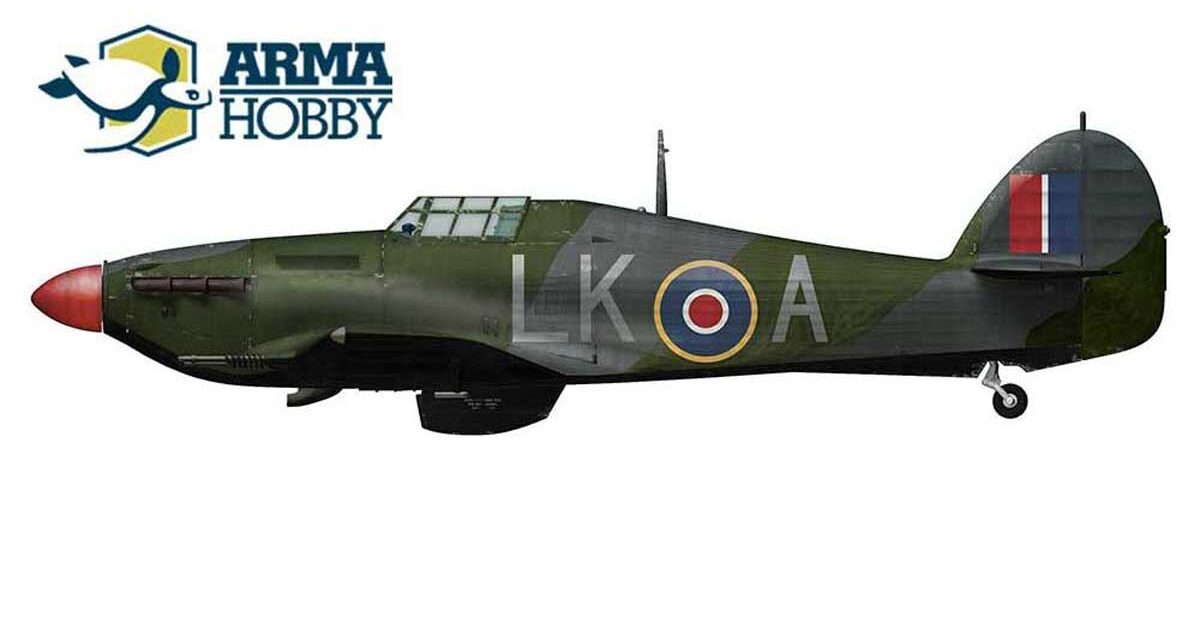
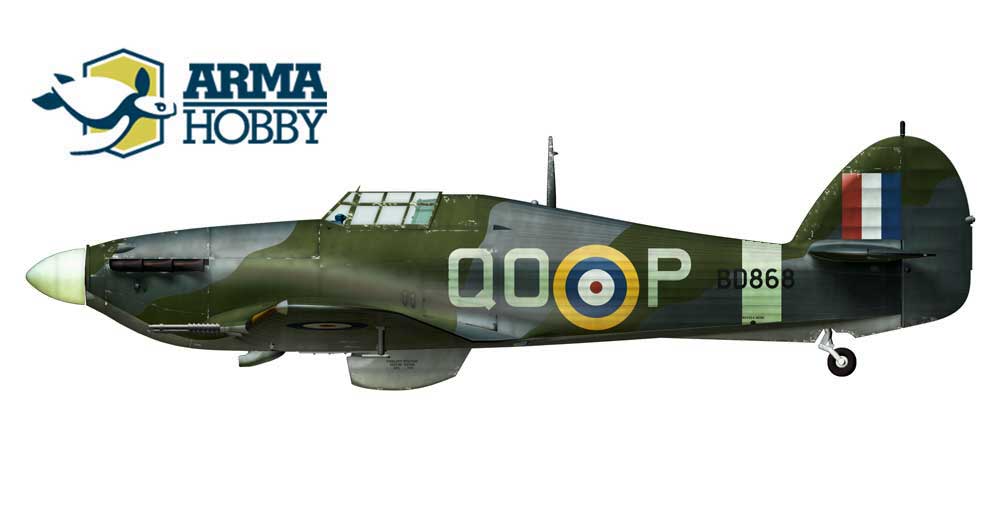


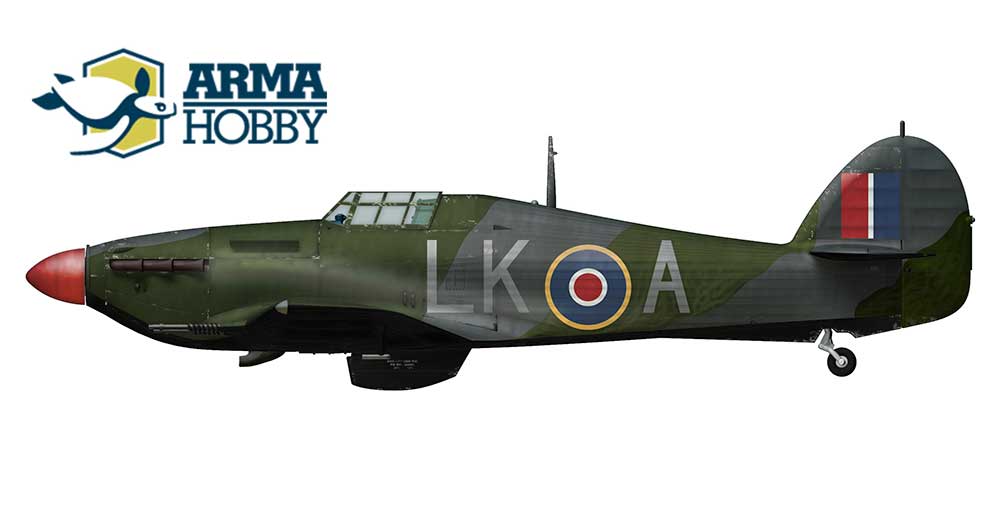



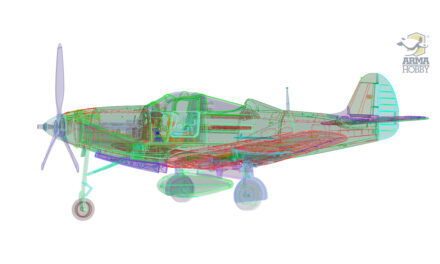
fantastic informarion on the hurrlcane what a model
Would love to see 1/48 scale Hurricanes from Arma. Are there any plans to offer those in the future?
Yes, further Hurricane project were announced on our blog here.
Will there be overtrees available as you did with the MkI kit please?
Thanks for giving the Hurricane so much love.
All the best
Paul
Thank you for question. Plastic parts offer is not yet ready. Most probably they will not be available this year.
Thank you for the reply
Looking forward to the Hurricane MkII kit
Can’t have enough Hurris!